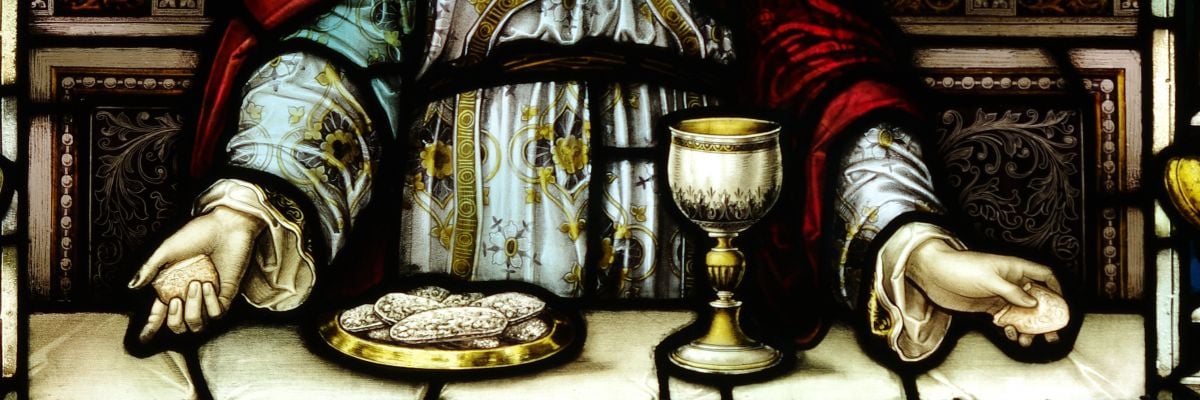
When it comes to defending the real presence of Christ in the Eucharist, Catholics naturally turn to Jesus’ words at the Last Supper:
Now as they were eating, Jesus took bread, and blessed, and broke it, and gave it to the disciples and said, “Take, eat; this is my body.” And he took a cup, and when he had given thanks he gave it to them, saying, “Drink of it, all of you; for this is my blood of the covenant, which is poured out for many for the forgiveness of sins. (Matt. 26:26-28, emphasis added)
In the past, we looked at one way a Protestant might counter. Let’s look at another.
Notice that when Jesus speaks of the contents of the chalice he says, “this is my blood of the covenant.” This is a direct allusion to the “blood of the covenant” that Moses sprinkled on the people to ratify the Mosaic Covenant on Mount Sinai (Exod. 24:8).
Now, a Protestant might draw our attention to the fact that the blood of the covenant was blood from a victim slain. Had the blood not been shed, it wouldn’t have been the blood of the covenant.
In light of this, it might be argued that because Christ’s blood had not been shed yet on Calvary when he spoke of the substance in the cup as his “blood of the covenant,” the contents of the cup couldn’t have been the blood of the New Covenant, for the blood of the New Covenant is Christ’s blood shed on the cross. And if that’s the case, so it might be argued, then the substance in the cup must have been merely a symbol of his “blood of the covenant” that would be shed the next day.
How could we respond?
First, the issue of whether real blood was present is different than the issue of whether that blood presently has the status of being “blood of the covenant.”
Consider the victims on Sinai, for example. Before they were slain, their blood didn’t have the status of being the “blood of the covenant.” But that doesn’t mean the blood present in the victims wasn’t real blood.
Christ’s blood at the Last Supper could still be present in the chalice even if it didn’t yet have the status of being the “blood of the covenant,” since he hadn’t been slain yet. And that’s all the doctrine of transubstantiation requires: Christ’s real and substantial blood was made present in the cup at the Last Supper.
Whether his real blood is technically the “blood of the covenant” at that moment doesn’t bear on whether the wine became Jesus’ blood. We could suppose, for the sake of argument, Jesus was simply speaking about the substance in the cup as his real blood that symbolizes “blood of the covenant,” or that would soon become “blood of the covenant,” but it would still be real blood.
Regardless, the attempt to show that Christ’s blood at the Last Supper doesn’t have the status of “blood of the covenant” doesn’t disprove transubstantiation, which is what the objection sets out to do.
Second, we can respond by challenging the claim that Christ’s blood at the Last Supper was not the “blood of the covenant.”
Remember, the objection holds that this is so is because Christ’s sacrifice hadn’t been offered yet on the Cross.
But why should we believe that Christ’s redemptive sacrifice is restricted to just the moment of his death? If we consider what the Bible teaches about sacrifices, there is good reason to think that Jesus’ redemptive sacrifice was not restricted to his death.
For example, death was a key moment in Old Testament sacrifices, but they didn’t begin at the moment of death. The sacrificial rituals consisted of many things that preceded death: bringing the animal into the sacred precincts (Exod. 29:42; Lev. 1:2-3), examining the animals for any blemish, placing hands on its head (Lev. 1:4; 4:15), the confession of sins by both the priest (Lev. 16:21) and the penitent (Lev. 5:5), etc. All of these things made up the one sacrifice.
Moreover, the New Testament teaches us that there’s such a thing as a living sacrifice. Paul tells the Romans, “Present your bodies as a living sacrifice, holy and acceptable to God, which is your spiritual worship” (Rom. 12:1). Elsewhere, he considers the Gentiles as his “offering” in his “priestly service of the gospel of God” (Rom. 15:16).
This wide range of what’s possible for sacrifices in God’s plan of salvation shows that Christ’s redemptive sacrifice may not have been restricted to his death, but may have begun while he was alive.
So did it?
The Catechism of the Catholic Church answers in the affirmative: “Redemption comes to us above all through the blood of his cross, but this mystery is at work throughout Christ’s entire life” (517, emphasis added).
Even if an individual doesn’t accept such an expansive understanding of Christ’s sacrifice, Protestant theologians universally identify Jesus’ sacrifice with his Passion as a whole.
On this we can agree: his redemptive sacrifice may reasonably include the sufferings that immediately led up to it and were intentionally directed toward the Crucifixion. The obvious example is his agony in the Garden where he requests three times that the Father remove the cup of suffering from him (Matt. 26:39-46).
Was Jesus already suffering at the time of the Last Supper (the relevant time frame for our purposes)?
Consider that Jesus would have been in distress over Judas’ betrayal, which he predicts at the Last Supper (Matt. 26:24-25; Mark 14:18-21; Luke 22:21-23; John 13:21-30). In John’s account, we even get a hint at Jesus’ inner suffering when he tells Judas, “What you are going to do, do quickly” (John 13:28). This suggests that Jesus isn’t looking forward to what is to come and—like most of us—wants to complete his Passion as quickly as possible without prolonging it.
Now, because this suffering at the Last Supper is directed to the Cross we can reasonably say it’s a part of his redemptive sacrifice. And since Christ’s redemptive sacrifice is the New Covenant institution sacrifice, we can conclude that the New Covenant redemptive sacrifice has already begun at the Last Supper.
Thus, at the time of the Last Supper Christ’s blood already had the status of “blood of the covenant”—the real and substantial blood of the New Covenant sacrificial victim present in the cup and the New Covenant redemptive sacrifice. Yes, the sacrifice would culminate in his death the next day. But his blood is still blood of the New Covenant sacrifice and thus reasonably can have the status of “blood of the covenant.”
So, because the appeal to the “blood of the covenant” of the slain victim in the Mosaic covenant fails to prove what it sets out to prove, and we have good reason to think that Jesus’ blood at the Last Supper has the status of “blood of the covenant,” this challenge to a literal interpretation of the words of institution fails.
There are further challenges to Catholic teaching on the Real Presence of Christ in the Eucharist, but we’ll save those for another time.



